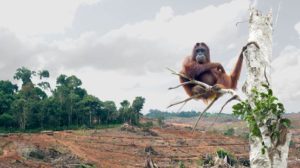By saving nature (or what’s left of it) we’ll be saving ourselves
 4 Mei 2020
4 Mei 2020
For great numbers of people, especially those living in overpopulated urban areas where only the odd parks serve as small patches of greenery, nature is something out there somewhere.
Many city dwellers have come to see nature, if they ever think about it at all, as an amorphous entity of sorts that is divorced from their daily experiences in urban metropolises. Who can blame them? Already more than half of people on the planet (55%, to be precise) live in urban areas, according to the United Nations. By 2050 more than two-thirds of the world’s ever-increasing human population (or around 68%) will live in towns and cities, according to the UN’s projections.
“Today, the most urbanized regions include Northern America (with 82% of its population living in urban areas in 2018), Latin America and the Caribbean (81%), Europe (74%) and Oceania (68%),” the UN notes. “The level of urbanization in Asia is now approximating 50%. In contrast, Africa remains mostly rural, with 43% of its population living in urban areas.”
Millions of people in urban areas have any experience of the natural world beyond manmade urban habitats only when they go on holiday for a week or two once or twice a year. Untold millions of others do not have this benefit at all, lacking the financial wherewithal to travel and go on holiday.
In tandem with our separation from it, the natural world has come to be widely seen as merely a resource-rich depository that we can exploit at will for our own needs. Forests can provide us with timber. Flatlands and rolling hills can provide us with yet more agricultural land. Oceans can provide us with fish and other types of seafood.

Yet if there is anything the current COVID-19 pandemic has made abundantly clear it is that we are destroying nature at our own peril.
There is some evidence that the novel coronavirus, which causes the potentially deadly disease, may have jumped to us from pangolins. These placid scaly anteaters have been driven to the edge of extinction throughout their ranges across Africa and Asia simply because their scales are believed erroneously to have medicinal properties by practitioners of traditional Chinese medicine.
What is in little doubt is that wildlife markets in China and elsewhere have been breeding grounds of diseases by bringing various wildlife species into close proximity with one another and humans in unhygienic conditions. Whatever the origin of the new coronavirus, there is no denying that the relentless illegal wildlife trade, rampant deforestation and other environmentally destructive practices have increased the risk of similar pandemics, to say nothing of other manmade calamities.
“There is a single species that is responsible for the COVID-19 pandemic – us,” stress scientists at the Intergovernmental Science-Policy Platform on Biodiversity and Ecosystem Services (IPBES) in a public statement. “As with the climate and biodiversity crises, recent pandemics are a direct consequence of human activity – particularly our global financial and economic systems, based on a limited paradigm that prizes economic growth at any cost,” they explain. “We have a small window of opportunity, in overcoming the challenges of the current crisis, to avoid sowing the seeds of future ones.”
The experts have highlighted wanton deforestation, rampant infrastructure development and the uncontrolled expansion of agriculture and intensive farming as some of our especially destructive practices. These and the exploitation of wild animals “have created a ‘perfect storm’ for the spillover of diseases from wildlife to people,” they observe.
The solutions lie in abiding by far more ecofriendly practices in coming years and decades.
“First, we must ensure the strengthening and enforcement of environmental regulations – and only deploy stimulus packages that offer incentives for more sustainable and nature-positive activities,” the experts argue. “It may be politically expedient at this time to relax environmental standards and to prop up industries such as intensive agriculture, long-distance transportation such as the airlines, and fossil-fuel-dependent energy sectors, but doing so without requiring urgent and fundamental change, essentially subsidizes the emergence of future pandemics.”
For a stark example of the collosal environmental devastation from rampant deforestation, we need look no further than the islands of Borneo and Sumatra in Southeast Asia. Local forests are among the most biologically diverse habitats on the planet. They are the natural habitats of such iconic and unique species as orangutans, pygmy elephants and Sumatran rhinos.
All of these species are now critically endangered because of poaching and extensive habitat loss. In recent decades most local forests have been devastated by logging while vast swathes of formerly pristine rainforest have been turned into oil palm plantations and agricultural land. Even many of those forests that are left have been badly thinned and fragmented.
“A century ago, most of Borneo was covered in forest. But the region has lost over half of its forests, and a third of these have disappeared in just the last three decades,” the World Wide Fund for Nature notes.

“The increase in these activities is being matched by a growth in illegal wildlife trade, as cleared forests provide easy access to more remote areas,” the WWF adds. “Only half of Borneo’s forest cover remains today, down from 75 per cent in the mid 1980s. With a current deforestation rate of 1.3 million hectares per year, only peat and montane forests would survive in the coming years.”
The situation is hardly better in the planet’s oceans where numerous marine species have been fished to the point of near-extinction while manmade activities like plastic pollution are having similarly devastating impacts.
Climate change, meanwhile, is devastating coral reefs in tropical waters that are rich and biodiverse habitats. Coral reefs are home to a quarter of all marine species, even though they occupy a mere 1% of the ocean floor. The combined effects of warming temperatures, acidification, water pollution and mass tourism have dealt a blow to many of the world’s corals.
Time is running out for life on the planet as we know it. Unless we change our ways and fast, we’ll be left with an Earth that is a mere sad shadow of the majestic planet we have inherited.
The post By saving nature (or what’s left of it) we’ll be saving ourselves appeared first on Sustainability Times.
